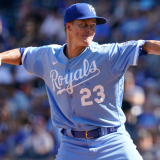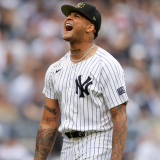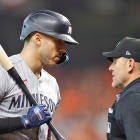In October, we reported that the Boston Red Sox had been gauging other teams' interest in their players even before hiring new point guard Chaim Bloom. Boston's goal was to set the groundwork for an offseason in which the team is expected to slash payroll to get underneath the luxury-tax threshold. As we explained then, doing so would mean trading one of their better players -- be it Mookie Betts, J.D. Martinez, or David Price. At this point, Price appears to be the likeliest to go, with the Red Sox being known to have discussed his situation with a number of teams.
What would a Price trade mean for Boston's luxury-tax situation, and where might he land?
We'll start with the financial implications. At present, the Red Sox are projected to have an Opening Day payroll of $221 million, per Cot's Contracts. Their luxury-tax payroll is lower than that, at $218 million -- or a good $10 million over the threshold. The Red Sox's presumed intent is to get far enough under that line that they can make additions to their roster without having to pay the overage penalties for doing so.
Trading Price might be the best way to reduce the number. He'll make $32 million in each of the next three seasons, but his contract's annual average value is a team-leading $31 million -- meaning the Red Sox's luxury-tax number would dip to $187 million if they traded him and received nothing in return. In theory, the Red Sox would have up to $20 million to spend without crossing the line. They're also expected to move Jackie Bradley Jr., which would free up another $11.5 million.
| 2020 BASE SALARY | 2021 BASE SALARY | 2022 BASE SALARY | 2023 BASE SALARY | |
|---|---|---|---|---|
David Price
BOS SP
| $32M ($31M luxury tax salary) | $32M | $32M | UFA |
Those two moves would give Bloom more than $30 million in breathing room. That doesn't mean he'd spend all that this winter. Teams tend to like to hold $10 million (or so) in reserve for in-season additions. Ownership's desire to avoid the tax would also, likely, lead to him shortchanging himself. Effectively, Bloom would probably have around $20 million to make necessary additions -- a starter or two, a reliever or two, and perhaps an outfielder. The Red Sox would be value shopping, in other words.
All of this is being done to avoid a trifling penalty. Say the Red Sox were to end next season $15 million over the luxury tax -- or with a CBT calculation of $223 million. Their penalty would be $7.5 million as a three-time offender. That's it. If they were to finish $30 million above the threshold -- $238 million -- they would pay $16.2 million. That's a little steeper, but it goes to show that the fees aren't cruel and unusual -- well, unless one is the poor billionaire owner of a highly profitable team, anyway.
While it seems like an afterthought in this process, it's worth noting that Price remains a quality pitcher. He's not his old ace self in stuff (his fastball was down to 92 mph on average last season, to which he adjusted by becoming more reliant upon his changeup) or durability, as he's averaged just over 20 starts per pop the past three years. But, when Price has been on the mound during that time, he's been effective: accumulating a 122 ERA+ and a 3.59 strikeout-to-walk ratio. For perspective, only 29 starters have topped 350 innings with an ERA+ better than 110 and a strikeout-to-walk ratio over 3.00 since 2017 -- you can see the names here; it's a good group full of aces and No. 2 starters.
Will Price maintain that standing for the next three seasons? Probably not. But a team acquiring him could reason that he's a better bet to fend off aging effects than the average bear, given his command and his willingness and ability to adapt. (It doesn't hurt that he's regarded as a plus in the clubhouse, either.) As such, it shouldn't surprise anyone that a number of teams have interest in acquiring his services.
Let's tackle the seven teams who seem like the most realistic landing spots.
1. Los Angeles Angels
The Angels lost out on Gerrit Cole overnight, and aren't a lock to nab Anthony Rendon. They have the payroll flexibility and the need to add an above-average starter (or two). Acquiring Price wouldn't necessitate giving up a top prospect, either -- and heck, if they take the whole deal, maybe they can convince the Red Sox to throw in a sweetener.
2. Texas Rangers
The Rangers are in the running for Rendon as well. They've already addressed their rotation twice this winter, signing Kyle Gibson and Jordan Lyles. Going back to the well for a third time would make some sense if they come up short on Rendon and/or Josh Donaldson and resort to a low-cost third-base option.
3. Los Angeles Dodgers
Another team who lost out on Cole. Andrew Friedman is familiar with Price from their shared days in St. Petersburg, and might reason with himself that Price is cheaper than signing Madison Bumgarner. Of course, Friedman passed on signing Price originally, so who knows.
4. Chicago White Sox
The White Sox have already thrown some coin around this winter. They haven't been able to address their rotation, coming up short on Zack Wheeler, among others. Price would be a welcomed addition.
5. San Diego Padres
The Padres are on the hunt for a front-of-the-rotation starter and would love to shed Wil Myers' contract. The luxury tax isn't a social experiment dreamt up by Stanford psychologists, but it would be amusing to see the Red Sox take back Myers' deal, in part because his luxury-tax figure is lower than his actual salary. Sometimes you have to spend money to save money, or something.
6. San Francisco Giants
Farhan Zaidi has already leveraged his financial might to take on Zack Cozart in exchange for a prospect. If he wants to go full NBA general manager -- taking on other teams' regrets and albatrosses in exchange for a sweetener -- then doing the same here, with an eye on flipping Price himself, would be a fun wrinkle.
7. Minnesota Twins
The Twins are linked to a number of veteran free-agent starters. They'll probably land one of those, but Price would make for an interesting fallback option.























